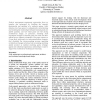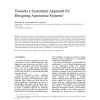815 search results - page 2 / 163 » Using non-functional requirements to systematically support ... |
RE
2004
Springer
13 years 10 months ago
2004
Springer
We present a method to identify stakeholders and their preferences about non-functional requirements (NFR) by using use case diagrams of existing systems. We focus on the changes ...
CORR
2010
Springer
2010
Springer
Reliable Mining of Automatically Generated Test Cases from Software Requirements Specification (SRS)
13 years 5 months ago
Writing requirements is a two-way process. In this paper we use to classify Functional Requirements (FR) and Non Functional Requirements (NFR) statements from Software Requirement...
BMCBI
2006
13 years 5 months ago
2006
Background: Publicly accessible EST libraries contain valuable information that can be utilized for studies of tissue-specific gene expression and processing of individual genes. ...
RE
2001
Springer
13 years 9 months ago
2001
Springer
Today's requirements engineering approaches focus on notation and techniques for modeling the intended functionality and qualities of a software system. Little attention has ...
WIAS
2010
13 years 3 months ago
2010
An autonomic system is a system capable of managing itself and adjusting its actions in the face of environmental changes. Autonomic systems are currently developed using ad-hoc ap...


